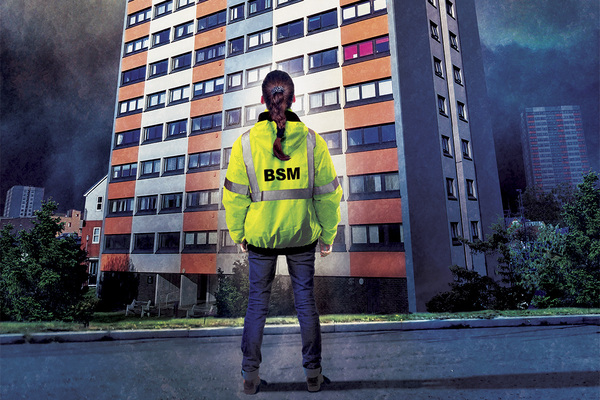You are viewing 1 of your 1 free articles
The disappearing act: cuts to building control professionals and what they mean for building safety
Councils have significantly cut their building control teams over the past decade. Peter Apps finds out why and how it may have contributed to the building safety crisis we face today. Illustration by Kerry Hyndman
A tower block refurbishment in west London comes up for consideration by the council’s building control department.
It is a complex refurbishment project in a high-rise building. Previously this would have been taken up by the local authority’s ‘special projects team’ of surveyors who handled the most complex work in the borough.
But the council had restructured its team a year before. The special projects team had been abandoned and projects were simply allocated to whoever covers that geographical patch of the borough – regardless of their levels of expertise, experience and specialism. The restructuring saw the size of the team reduced from 12 members to between four and five, and the surveyor’s workload increased commensurately.
This turned out to be a surveyor who, despite working for the council for 31 years, would be taking on his first special project and his first high-rise job.
He would go on to make a number of critical errors which would ultimately result in a highly combustible and non-compliant cladding system being signed off for use on the external walls.
The surveyor in question is John Hoban, the authority is the Royal Borough of Kensington and Chelsea (RBKC) and, as you have probably deduced by now, the building is Grenfell Tower.
When he gave evidence to the Grenfell Tower Inquiry, Mr Hoban spoke bitterly about his working conditions: how the reduction in workforce had placed the remaining surveyors under undue pressure.
“They lost 10 surveyors who had 230 years’ experience and there was one replacement, who was a graduate, and I don’t believe that’s the correct way to run a department,” he said.
As with much of the evidence uncovered at the Grenfell Tower Inquiry over the past 18 months, this story represents a more systemic failure.
Inside Housing’s new and exclusive research suggests that local authorities across the UK, not just RBKC, have been making extensive cuts to their building control departments. We asked local authorities across the UK to provide figures for the size of their building control teams in 2010 and corresponding figures for 2020. The results reveal a sharp decrease.
The 85 councils able to provide figures employed 707 full-time equivalent building control staff in December 2010, but by December 2020, this had fallen to 513 – a 27.4% reduction. If this is representative, it would mean councils lost in the region of 1,400 building control staff across the decade.
Why has this happened? What has the impact been? And is it part of the reason we face such a stark building safety crisis today?
The first point to make is that the staff reductions are not uniform. There are several authorities where – similar to RBKC – the reduction has been very sharp. Trafford Council in the North West, for example, started the decade with 10 building control surveyors and by 2020, it was down to two. Bexley Council in south-east London, meanwhile, went from 11.6 full-time equivalent staff to 3.8. Sunderland Council dropped from 11 to five.
A spokesperson for Trafford Council says the number of surveyors it employed had dropped “because of natural retirements” and “significant competition” from the private sector for staff. However, it adds it is “committed to developing a stronger in-house team” and will be recruiting more staff going forward.
A spokesperson for Sunderland Council says its reductions “reflected reviews and the remodelling of the council’s infrastructure, planning and transportation sections”.
Bexley Council did not respond to requests for comment.
For the majority of local authorities, though, the reduction has been more modest: 44 of the 85 councils that responded have reduced their headcount by between one and four members of staff. With small teams in place at many councils, however, small reductions can still be significant: 33 of the local authorities to respond (38% of the total) have cut their teams by more than a third.
A proportion of authorities have also moved to a shared service – where building control is delivered as a partnership between two or more councils – resulting in reductions to the overall headcount. There are also eight councils where the headcount has marginally increased.
Finally, there are a group of councils (four in our survey) where the local authority building control service has been outsourced entirely, with a total of 31 building control surveyors lost.
Sometimes this is due to a move to a shared service: East Herts and Broxbourne, for example, employed 19 staff in 2010, but have since handed over responsibility to a Hertfordshire-wide service in which they are simply shareholders with other authorities in the council.
Top seven council areas with the biggest reduction in building control staff
Local authority | Staff in 2020 | Staff in 2010 | Total reduction |
Cheshire East | 10 | 22 | 12 |
South Lanarkshire | 20 | 30 | 10 |
Trafford | 2 | 10 | 8 |
Bradford | 23 | 31 | 8 |
Bexley | 3.8 | 11.6 | 7.8 |
Flintshire | 5 | 12 | 7 |
Sunderland | 5 | 11 | 6 |
Notes: This table excludes councils where the building control service has been outsourced to a private provider, another authority or shared service. Figures are accurate as at on date of Freedom of Information (FOI) request – December 2020. Source: Inside Housing FOI research
Derbyshire Dales Council now provides its services through private provider DBCP.
Outsourcing aside, why the reductions? The easy answer would seem to be austerity, but this would miss a more nuanced picture.
In 2010, new financial rules were introduced covering councils’ building control departments. This offered the opportunity to set fees locally – which was thought to be necessary for local authority building control to remain competitive with private operators. But in return they had to run a cost-neutral service.
The service was to be funded through the fees charged to builders and these were ringfenced so they could not be siphoned off to cover up for cuts elsewhere. It was up to the local authorities to set the fees at a level which could fund the service.
Building control services are required for all forms of job: from conservatory extensions to the construction of skyscrapers. Not all of these are likely to turn a profit and local authorities are obliged not to turn them down. This may have led to financial pressure. But they have not faced straightforward cuts.
“I find it very difficult for building control to turn round and say they have had cuts to their revenue from government because government doesn’t fund their revenue,” says Geoff Wilkinson, managing director of Wilkinson Construction Consultants.
His view is that the sector has instead suffered from a lack of skilled inspectors coming through. “It was obvious a few years ago that there was an age timebomb approaching, because when you looked at the number of surveyors over 50, you could see a large number were due to retire around now and recruitment had not been coming in to replace those people,” he says.
This is a factor that is likely to have been exacerbated by competition: since Margaret Thatcher’s reforms to the construction sector in the 1980s, builders can choose whether to use a local authority building control service or to appoint a private ‘approved inspector’ –who are also surveyors with the same qualifications but work commercially for the builders as a client.
Private providers are likely to be able to pay higher salaries than their local authority counterparts, cranking up competition for a small pool of staff.
When asked about the reductions, Lorna Stimpson, chief executive of LABC, a representative group for local authority inspectors, says: “Has austerity touched local authority building control? I think austerity has touched all local authority services and that’s a bigger political issue. It is definitely something we are aware of at LABC, which is why we started over four years ago looking at performance standards and education. We are also recruiting people into public service building control and trying to keep them there – that has been an absolute priority for us.”
There are 340 trainees going through a new apprenticeship scheme at the moment designed to increase staffing levels – with at least 40% women. “Local authorities are starting to bring new recruits through, so it’s all going in the right way,” says Ms Stimpson.
In numbers
27.4%
Reduction of building control staff from 2010 to 2020
1,400
Number of staff lost by councils over the past decade
340
Trainees on a building control apprenticeship
Her colleague Martin Taylor, director of regulatory policy, adds that a large number of authorities do now operate a shared service which has “inevitably” reduced staffing numbers in some instances, but he emphasises the high levels of competence among the remaining surveyors.
But even with high levels of competence, is there not an impact from simply having less staff?
Mary-Anne Bowring, group managing director at Ringley Group, says she has noticed a change in the way building control operates from her early years in the construction sector.
“In my early days in construction, 25 years ago, the inspector would come by and visit the site and you never knew they were coming,” she says. “You always felt like they were keeping an eye on you. That has changed.”
She also says that recruitment has been a problem. “When I started, all the surveyors were 50-plus and they knew every building in the borough,” she says. “But they’ve got older and older and we haven’t seen the talent coming through.”
The draft Building Safety Bill sets out a vision of increased inspections and monitoring at various stages of construction – especially in higher-risk buildings. How will this be attainable with reduced staff?
“If the government is saying you need to increase the number of visits, how’s that going to happen if resource is decreased?” says Mr Wilkinson. “How do you produce a more thorough system if they’re already at the limit of capacity? And that’s before we even increase the number of homes we’re building.”
What role, if any, have these headcount cuts played in the building safety crisis we face today? The complexity of the crisis means it would be reductive to present any single factor as a complete answer.
Certainly, official building guidance – which permitted certain forms of cladding now known to be dangerous as well as other flaws – must take its fair share of the blame. However many inspectors the sector employed, they could only apply the rules in force.
Similarly, we have learned much about the way manufacturers tested and marketed their products as fire-safe when they were not. It is doubtful whether better resourced teams would have been more successful at spotting this.
But with greater site inspections and more time to review guidance and challenge claims about the suitability of some cladding products, we may have found ourselves in a better place today.
Staff reductions may only be a part of a complex picture, but they are part of it. And if we want to build a better system, this is an issue that must be addressed.
Sign up for the IH long read bulletin
Already have an account? Click here to manage your newsletters













